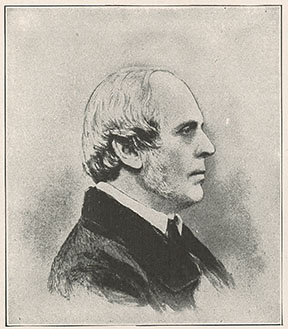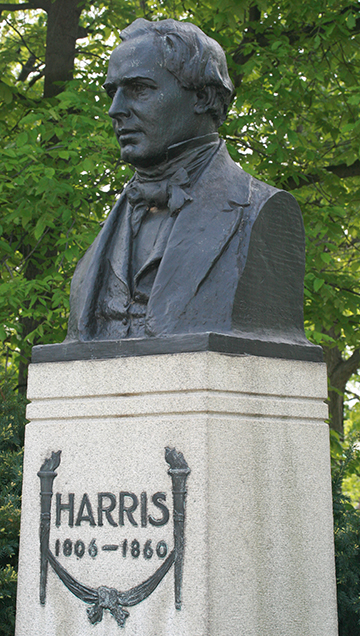<Back to Index>
- Dentist Chapin Aaron Harris, 1806
- Writer Willem Johannes Theodorus Kloos, 1859
- Holy Roman Emperor Henry II the Saint, 972
PAGE SPONSOR



Chapin Aaron Harris A.M., M.D., D.D.S. (May 6, 1806 in Pompey, N.Y. - September 29,1860 in Baltimore, Maryland) was an American physician and dentist and dentistry school founder.
At the age of 17 Harris studied medicine in Madison, Ohio, in the office of his brother, Dr. John Harris, who also tutored him in dentistry, a subject which become his main interest. He subsequently passed the Board of Medical Censors in 1824 and was licensed to practice medicine. He soon commenced practice in Greenfield, Ohio, were he remained for about one year, travelling to Bloomfield, Ohio, then Fredericksburg, Virginia. In 1828, Dr. Harris turned to full time dentistry, and by 1833 was a student of Dr. Horace Henry Hayden located in Baltimore, Maryland. Licensed by the Medical and Chirurgical Faculty of Maryland, Harris conducted an itinerant dental practice throughout the South, before settling permanently in Baltimore in 1835.
Harris received the honorary M. D. degree from Washington Medical College at Baltimore, in which he was a professor in 1838. Shurtleff College in Alton, Illinois, conferred an A.M. degree on him in 1842. His D.D.S. was obtained through membership of the American Society of Dental Surgery, and an honorary D.D.S. degree was conferred upon him by the Philadelphia Dental College in 1854. As
early as 1835 Harris became an active contributor to medical and
periodical literature as one of the most vigorous and productive dental
writers, causing him to be regarded as the founder of dental literature
in the US. He was also a contributor to medical and periodical
literature. With
the assistance and advice of three other physicians, he worked
tirelessly to establish the first dental school in the world.
Apparently his initial attempt was to establish a dental training
school attached to the Medical Department of the University of Maryland. This first attempt did not meet with success, possibly due to the opposition of Dr. H. Willis Baxley, one of the dental faculty. Undaunted,
Harris persevered in his efforts, and during the winter of 1839 - 40,
almost singlehandedly he gathered the signatures of representative
citizens for a petition to the legislature of the state of Maryland for
the incorporation of a College of Dental Surgery at Baltimore.
Surmounting the opposition of jealous medical rivals, he successfully
managed to obtain the charter and with the aid of Horace Henry Hayden,
Thomas E. Bond, H. Willis Baxley, S. Brown, E. Parmly and others, he
organized the Baltimore College of Dental Surgery in
1840. He was the school's first dean and professor of practical
dentistry. After Hayden's death in 1844, he became the school's second
president. The establishment of the Baltimore College of Dental Surgery is seen as one of the three crucial steps in the foundation of the dental profession in the United States. "
A true profession is built upon a tripod: a formal organization, formal
professional education, and a formal scientific literature. The United
States was the leader in all three. In 1839 - 40, the American Society
of
Dental Surgeons was organized, the Baltimore College of Dental Surgery
was established, and the first dental journal in the world, the
American Journal of Dental Science, was founded. At that time there
were only about three hundred trained and scientific dentists in the
entire country; the rest were relatively untrained operators, outright
quacks, or charlatans. In 1898, a list of the first subscribers to the
first journal was discovered and published by G.V. Black. These initial
subscribers may be considered the core group of truly professional
American dentists. They became the leaders of the newly born profession
of dentistry. " Harris was instrumental in all three. Harris died on September 29, 1860, due mainly to overwork.
Harris is considered one of the founding members of the profession of Dentistry in
the United States of America, father of American dental science, and a
pioneer of dental journalism. He has been inducted in the hall of fame
of the Pierre Fauchard Academy.
In 1840 he was the first to respond to the call of Dr. Horace Henry Hayden to organize the American Society of Dental Surgeons (ASDS). At a meeting at the home of Solyman Brown BA, MA, MD, DDS, in New York,
it was on his motion that the convention to organize a society
"resolved that a National Society be formed." He was its first
corresponding secretary and its president in 1844. After the disruption
of the society in 1856 due to the dental amalgam controversy, he was one of the foremost organizers of its successor, the American Dental Convention, serving as its president in 1856 - 57. In 1859, a year before his death, another national dental organization, the American Dental Association, was established during a meeting in Niagara, New York.
Before 1861 dentists were participant in both dental organizations,
which promoted education and research in all aspects of dentistry,
including dental materials and remainded active throughout the American Civil War (1861 – 1865). However, during the war, Southern dentists withdrew from them and, in 1869 established the Southern Dental Association. The Southern Dental Association merged with the ADA in 1897 to form the National Dental Association (NDA). The NDA was renamed the American Dental Association (ADA) in 1922.